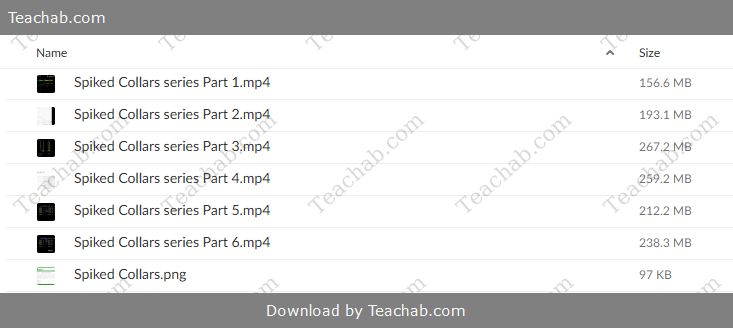SPIKED COLLARS (Dynamic Hedging)
$229.00 Original price was: $229.00.$15.40Current price is: $15.40.
Understanding Spiked Collars: A Comprehensive Review of Dynamic Hedging Strategies – Digital Download!

SPIKED COLLARS (Dynamic Hedging)
Overview

Understanding Spiked Collars: A Comprehensive Review of Dynamic Hedging Strategies
In the ever-changing world of financial trading, investors are constantly on the lookout for strategies that offer both risk protection and opportunities for profit. Spiked collars provide a sophisticated solution, blending aspects of options trading to create a dynamic hedging approach. This strategy not only enables investors to safeguard their investments but also allows them to capitalize on market movements. With a clear understanding of how spiked collars function and the benefits they bring, traders can navigate volatile market conditions more effectively. This review will explore the key concepts of spiked collars, their implementation, performance indicators, and important considerations for their use.
Key Concepts of Spiked Collars
The Structure of a Collar
A spiked collar is a unique structure designed for risk management, consisting of several key elements: ownership of an underlying asset, purchasing a put option, and selling a call option. Let’s break down each component:
-
Owning an Underlying Asset: The first step in creating a spiked collar involves owning an asset, such as stocks. This serves as the foundation for the hedging strategy.
-
Buying a Put Option: The put option acts as protection in case of market downturns. It allows the investor to sell the asset at a predetermined price, minimizing the potential for significant losses.
-
Selling a Call Option: To offset the cost of the put option, the investor sells a call option, generating premium income that can be used to fund the purchase of the put. However, this action caps potential profits—if the stock price exceeds the call option’s strike price, the investor may miss out on any further gains.
This combination of elements forms a “collar” around the asset’s price, providing a blend of downside protection and an upper limit on profits. This balanced approach can be particularly useful in unpredictable market environments.
Dynamic Adjustment
What sets the spiked collar apart is its ability to be dynamically adjusted. Unlike static collars that maintain fixed positions, spiked collars allow investors to actively manage their options according to market conditions. This dynamic flexibility is beneficial for investors who are adept at identifying market trends and responding quickly to changes.
For example, if an investor expects short-term volatility, they might sell short-term call options while maintaining the protective puts. This allows them to earn additional income from premiums without sacrificing downside protection. By continuously adjusting positions, skilled traders can improve their overall risk/return profile.
Engaging in dynamic adjustments requires vigilance and quick responses to market changes. This ability to adapt maximizes profit potential and minimizes losses during periods of uncertainty, making dynamic management a key component in optimizing performance through the spiked collar strategy.
Risk Management and Market Environment Suitability
Risk Management Benefits
One of the primary reasons investors choose the spiked collar strategy is its strong risk management capabilities. This approach allows investors to thrive in volatile markets by creating a balanced profile that appeals to both conservative and more aggressive traders. The key risk management advantages include:
-
Downside Protection: As mentioned earlier, the put option serves as a protective measure against market declines, offering a safety net even during periods of market turbulence.
-
Defined Risk/Reward Structure: The interaction between the sold call and the purchased put creates clear boundaries for both losses and gains. This predictability enables investors to make informed decisions based on their risk tolerance.
Market Environment Suitability
Spiked collars are particularly effective in certain market conditions. Their performance is generally more favorable in low-volatility markets, where price stability prevails. In these conditions, the risk of significant market moves is lower, allowing investors to take advantage of small fluctuations without facing substantial downside risk.
However, spiked collars can also be adjusted during periods of heightened volatility to lock in profits or manage risk according to market sentiment. For instance, an investor may opt to sell additional calls if they expect bearish trends, while using puts to protect against sudden market drops. The ability to adjust strategies in response to volatility allows spiked collars to deliver enhanced returns compared to traditional, static collar strategies.
Performance Examples and Case Studies
To understand the efficacy of spiked collars, consider comparing the performance of a traditional collar with that of a spiked collar in a real-world scenario. In various case studies, active management of spiked collars has shown to outperform static collars that do not adjust based on market conditions.
For example, imagine two investors: Investor A uses a traditional collar, while Investor B employs a spiked collar. In a month marked by high volatility, Investor B’s dynamic adjustments based on market shifts allow them to achieve significant returns, while Investor A’s fixed strategy limits their potential gains and exposes them to unnecessary risks.
Research from financial analysts also suggests that active management strategies like spiked collars generally lead to better overall portfolio performance. Investors who adjust their positions based on market dynamics tend to outperform those relying on static strategies, benefiting from both risk protection and profit potential.
Implementation Considerations
Prerequisites for Success
Executing a successful spiked collar strategy requires more than just entering the options market. Investors need a solid understanding of options pricing, including the nuances of bid-ask spreads, volatility estimates, and the time value of options. Keeping up with market trends will further enhance an investor’s ability to make timely adjustments.
Additionally, before adopting a spiked collar strategy, an investor must assess their own risk tolerance. Since this strategy involves active management, it may not be suitable for those who prefer a passive, buy-and-hold investment approach. Aligning the strategy with personal investment philosophies is essential for ensuring comfort with the required level of involvement.
Guidelines for Successful Implementation
To effectively implement a spiked collar strategy, investors should follow these key guidelines:
-
Regular Monitoring: Continuously track market trends and the performance of the underlying asset to allow for timely adjustments.
-
Understand Market Conditions: Recognize periods of volatility and stability, adjusting collar positions accordingly.
-
Maintain Risk Awareness: Always assess the potential outcomes of adjustments to ensure preparedness for varying market conditions.
-
Utilize Technology: Leverage trading platforms and tools that help manage options portfolios efficiently, facilitating quick decision-making and adjustments.
-
Practice and Refine: Consider using a simulated account to practice the strategy before committing significant capital, gaining valuable experience without the risk of actual financial loss.
By adhering to these guidelines, investors can effectively utilize spiked collars, optimizing risk management and capitalizing on dynamic market conditions.
Conclusion
Spiked collars represent an advanced dynamic hedging strategy that incorporates options trading principles to offer both protection and potential profit. By combining ownership of an underlying asset, buying put options, and selling call options, investors can manage risk while also taking advantage of favorable market movements. The ability to dynamically adjust positions further enhances profitability and improves portfolio performance.
For those willing to engage actively with market trends, spiked collars provide a compelling strategy. By understanding their construction, risk management benefits, performance advantages, and practical considerations, investors can leverage this sophisticated tool to navigate the complex landscape of financial markets successfully.
Frequently Asked Questions:
Business Model Innovation: We operate a group buying strategy, allowing participants to share costs and access popular courses at reduced prices. This model benefits individuals with limited financial resources, despite concerns from content creators about distribution methods.
Legal Considerations: The legality of our operations involves complex issues. Although we don’t have explicit permission from course creators to resell their content, there are no specific resale restrictions stated at the time of purchase. This ambiguity creates an opportunity for us to provide affordable educational resources.
Quality Control: We ensure that all course materials purchased are identical to those offered directly by the creators. However, it’s important to understand that we are not official providers. As such, our offerings do not include:
– Live coaching calls or sessions with the course author.
– Access to exclusive author-controlled groups or portals.
– Membership in private forums.
– Direct email support from the author or their team.
We aim to reduce the cost barrier in education by offering these courses independently, without the premium services available through official channels. We appreciate your understanding of our unique approach.
Be the first to review “SPIKED COLLARS (Dynamic Hedging)” Cancel reply
You must be logged in to post a review.

 Utah Legal and Ethical Issues for Mental Health Clinicians By Susan Lewis - PESI
Utah Legal and Ethical Issues for Mental Health Clinicians By Susan Lewis - PESI 















Reviews
There are no reviews yet.